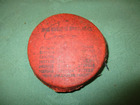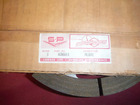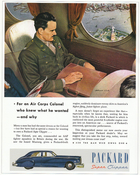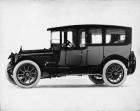|
Re: Larry's 1951 Club Sedan Project
|
||||
|---|---|---|---|---|
|
Forum Ambassador
|
Very nice bushings. The flexane does seem to hold up very well. Those I did several years ago still look good.
Re the poison and chrome problem, wonder if some of the kits advertised as "environmentally friendly" could be used in Australia. Here are a couple saying no hazardous products -- one can even be shipped by air (at least in US). Haven't seen any work done by the process so can't comment on whether it would be worth trying or would even look like the real stuff next to a piece that was done the old way. caswellplating.com/kits/copychrome.htm caswellplating.com/kits/reprochrome.html
Posted on: 2010/4/28 8:19
|
|||
|
||||
|
Re: Larry's 1951 Club Sedan Project
|
||||
|---|---|---|---|---|
|
Home away from home
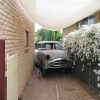
|
That's interesting HH56, thanks for the info. I looked at Caswell's kits a year or so back and noticed they had the Nickel-Cobalt kit back then, which was deemed to give a finish 'like chrome'. (Those are available here).
Had not been to their site recently to see the ReproChrome and CopyChrome kits. These sound pretty good, I wonder if one of them is the former Nickel-Cobalt kit re-named? Also great to know that if I want either kit I can have one air-freighted to Oz. Will keep that in mind. I want to try out my Nickel system first and see how good a result I can get, then possibly try the 'Nickel-Cobalt' system and see how much better it is. Will post after I have done that! Edit: Here is the link to a Cobalt-Nickel Kit provider in Oz, I have had dealings with this supplier. Jane Kits
Posted on: 2010/4/29 8:20
|
|||
|
1951 Packard Club Sedan | [url=ht
|
||||
|
||||
|
Re: Larry's 1951 Club Sedan Project
|
||||
|---|---|---|---|---|
|
Home away from home

|
Cavity Sealing, Rust-proofing, Priming and Painting
Because rust had done quite a lot of damage to the Coupe over its 50 years of life I had to think long and hard about which of the many different products and combinations of primers, undercoats, sealants and cavity waxes etc that could be used. I wanted to gain the absolute best protection for the car, and cost or hours required was not a big consideration. It is not an easy thing to decide which anti-corrosion and paint systems to use, as there are dozens of supposedly good products available. Some issues that I needed to consider were - - Toxicity of primers and paints (isocyanates in 2-pak systems are very toxic, and special care is needed even when sanding back dry coats). I want a DIY product as I'm intending to do all surface prep and spraying myself. It might not be a 100% finish but cars I've sprayed over the years have probably been around the 90% level, and it is really enjoyable to know the final 'gleam' of the finish is something that you achieved yourself. - Did I want to stay traditional and use the finish originally used (acrylic), or make use of tougher systems like 2-pak? - Would I be able to achieve really good results easily if the need arose for re-painting the Coupe's paintwork at some future time? Modern 2-pak paint may prove to be more problematic if fixing a scratch or repainting a few small areas in a year or three. - Cost of product versus results. Some finishes are four times the cost of others . . . - Whether to use 'permanently tacky' cavity wax or a rust preventive that will form a dry film. Which is best? The tacky ones will attract dust but work extremely well and last a long time. - Should I use the traditional 'dum-dum' joint sealer, or a more modern type like a polyurethane?? - How about stone-guard coatings - are the bituminous compounds better than others? - Should I use epoxy primers etc under stone-guard coatings and on some metal (like floor pans), or go POR-15? Well, I'm slowly working through these choices, and trying to make sure that I don't choose some incompatible mix of products that will give poor results. Having seen a good paint job lift off the metal due to a failed etch primer makes me a bit concerned about adhesion of paint systems. I reckon the biggest problem you can encounter (aside from rust forming under a coating) is poor adhesion of paint. So my aim is to get the best adhesion so there will never be a problem in that regard. So far the 'winning' primer for external surfaces is the PPG Epoxy-Urethane 2-pak primer. It's dear as poison (- probably because it is poison!). It has to be applied in specific ways, and costs a bomb but has great rust prevention and adhesion. One of the limitations for this PPG primer is that the final paint (base coat) has to be applied within hours of the primer being applied. Otherwise a second coat of the primer needs to be applied just before the colour coat. So if you have your Packard sitting around for a few months or years in primer, it has to be rubbed back and primed again just before final painting. This is not the case with many other single-pak primers. A problem I have had more than a few times is the quality of information that you get from the technical 'experts' when you call the Helpline of a paint or coatings company. Ring twice and you'll probably get two different answers which is a concern. For example, when speaking to one 'expert', I told him the car had been grit-blasted and some areas had been primed (with rich zinc primer) but other areas had not been primed yet. According to this person, once a car has been blasted, you need to get it primed within a few hours, or any subsequent primer / paint etc will just trap moisture under it and the metal will rust badly. Well, most automotive paint companies say that is not correct. When you apply their particular primer over any bare metal then there is no chance of rust forming provided the surface was prepared properly. So technical support often leaves a bit to be desired. I'm sure that properly prepared bare metal will not rust after a good coat of primer and colour is applied over it, despite sitting around for months after grit blasting. But of course some surface rust is likely to form after a while (depending on climate etc), and this has to be totally removed and the surface treated (Phosphoric acid). I have been protecting bare metal with a lanolin surface spray which seems to work very well. No rust has formed at all with this coating over the bare metal. The lanolin can easily be removed with water followed by thinners etc. I still have many decisions to make, but I've made a couple of choices already, having settled on painting the entire underside floor pan with POR-15 (after properly treating with Metal Ready). And various mudguards (fenders), trunk lids etc are getting the PPG Epoxy-Urethane primer even though I'm leaning towards using traditional acrylic as the topcoat, rather than a 2-pak finish. At least I will have the opportunity to go 2-pak if I decide to, by having used the right primer for 2-pak. The final paint job is still a long time off into the future. Will post about the products chosen later . . . .
Posted on: 2010/7/1 7:35
|
|||
|
1951 Packard Club Sedan | [url=ht
|
||||
|
||||
|
Re: Larry's 1951 Club Sedan Project
|
||||
|---|---|---|---|---|
|
Home away from home

|
Cleaning and Painting Underside
This work completed a couple of months ago . . . I'm running quite a ways behind with my posts, plenty of distractions due to family matters lately. This result is after days of laying under the body getting covered with the gunk scraped off, then getting dripped on by kerosene and thinners as I wiped every surface several times to get it totally clean. A lot of the surface needed to be sanded as well. Then there were two washes with Metal Ready before the POR15 was applied (by brush). Not a pleasant job, but really worthwhile and satisfying when you consider how foul the underside of the car was before it was cleaned and painted. I'm very happy that this work was done with the body on a frame, separated from the chassis. I had plenty of room to get in and under the body, and could get at all the difficult sections. The finish is two coats of POR15. Here are pics taken before and after. What we have here is an awful lot of crud!!     Then after cleaning . . .     And finally - painted      
Posted on: 2010/7/1 7:53
|
|||
|
1951 Packard Club Sedan | [url=ht
|
||||
|
||||
|
Re: Larry's 1951 Club Sedan Project
|
||||
|---|---|---|---|---|
|
Home away from home

|
Great job...looks fantastic! Any tips you have to get such a nice paint job using a brush?
Posted on: 2010/7/2 7:41
|
|||
|
[url=h
|
||||
|
||||
|
Re: Larry's 1951 Club Sedan Project
|
||||
|---|---|---|---|---|
|
Home away from home

|
The POR15 is a breeze to put on with a brush! Has amazing gloss, about as good as a spray job.You can get some bubbles forming if you put too thick a coat on for the first or second coat but that's rare. I think the biggest cause of problems is a 'bitty' finish. If you brush a place that hasn't been 100% cleaned then the brush picks up some particles and they end up all over the job! Then a rubbing back is mighty hard work, being the toughness of this paint. So the clue is spotless cleaning before starting, and that takes a heap of time. And make sure you use MetalReady thoroughly (twice) before painting.I'm really pleased with the POR finish, it should make future cleaning really easy, and keep any rust away for a long time.How are you progressing with your '51 Charles? You have a big lot to do by the look of it, but at least it is drivable!
Posted on: 2010/7/14 20:07
|
|||
|
1951 Packard Club Sedan | [url=ht
|
||||
|
||||
|
Re: Larry's 1951 Club Sedan Project
|
||||
|---|---|---|---|---|
|
Home away from home

|
Air cleaner / Silencer Restoration
A couple of air cleaners I have were in good condition apart from a few small dents and the need for a coat of paint. They had sat around a few months since being stripped and grit blasted, and some surface rust had set in, so a lot of 'elbow grease' was used to remove this, using 180 / 240 grit paper. It took a few hours, teaching me a lesson about not leaving blasted metal bare for a long period of time. I could easily have given them a spray of light oil (Lanolin) but was too busy getting on with other tasks to notice the rust forming. After as much panel beating as possible I had a few very minor low spots to fill, and considered lead wiping as a method. Noticed that quite a few dents on the coupe had been filled with lead way back - probably in the early years when the dangers of lead fumes were little known. I remember as a trainee telecommunications tech I did a full week of 'Lead Wiping" at the Lineman's training college. (Larger phone cables have a lead outer sheath which needs to be 'plumbed' with Plumbum (what a great word!) to keep water out of the typically paper insulated wires). None of us dozen or so trainees wore a mask of any kind for the entire week. However I decided to use polyester filler instead of lead. U-Pol Top Stop Gold works well, it's my choice for workability and ease of finishing for light / thin builds. (Thick builds require a different U-Pol product). The U-Pol packaging is a great improvement over the old style 'tins' of filler, with an easy-dispense bladder which you can knead and squeeze out enough, then put the screw cap back on - all very easy compared to 'scraping' the stuff out of a tin with a spatula. After all the sanding to achieve the right shape a few coats of combined primer-surfacer were sprayed on and re-sanded, then the acrylic gloss black applied. In the past I had always used separate primer and spray putty but it is worth noting just how much quicker and simpler it is to use the combination product. Especially faster from the viewpoint of when you are rubbing back for the perfect result and get down to bare metal in a few places. Then it was prime those areas again, leave to dry, then respray with spray putty. Now you can just respray with the combo primer- spray putty saving loads of time. The results seem very good with this product. Here is the first application of the filler, it took three applications before all nicks were filled properly.      Here is the end result - immediately after spraying and yet to be cut / buffed for a good shine.   
Posted on: 2010/8/3 18:22
|
|||
|
1951 Packard Club Sedan | [url=ht
|
||||
|
||||
|
Re: Larry's 1951 Club Sedan Project
|
||||
|---|---|---|---|---|
|
Home away from home

|
EasyBeat Repairs
Time to catch up with my project blog posts again after six months' absence. We've been on an extended trip, part of which was occupied spending Christmas with my wife's family in the north of England. We had a White Christmas due to all the snow that fell in early December. Now starting to get some feeling back into the 'extremities' as they slowly thaw!! I reckon snow is a love/hate relationship, and sympathize with anyone who has to spend months with it every year. Lol Now I'm keen as mustard to get into the project again. Here are a few pics of dent repairs done on my '51 Coupe using an EasyBeat machine. Most would be aware of this great method of pulling out dents - but in case you haven't here's the briefest of descriptions. A current passes through the electrode, effectively welding it temporarily to the metal panel, in a way similar to using a spot welder. There is a slide hammer on the unit which jerks the dent and at the same time breaks the weld bond, releasing the electrode from the car's panel. There is also an attachment for this unit that spot welds a number of wire 'clouts' and the pulling action (via a slide hammer) can be spread over a larger area. This is ideal for evenly straightening a crease or groove / scrape along a panel. This method is ideal for the final part of small dent removal, and with care it can get the panel so accurate that it is ready to prime and paint, with usually only the need for a thin build of spray putty. The EasyBeat in place . . .  Pressing the trigger produces a brief high current that welds the electrode to the panel  The final result can be very accurate. No need for applying hammer and dolly which might be difficult or impossible to do.  The low spots can be revealed by lightly sanding with 120-grit over the area, to highlight the depressions. 
Posted on: 2011/3/11 20:13
|
|||
|
1951 Packard Club Sedan | [url=ht
|
||||
|
||||
|
Re: Larry's 1951 Club Sedan Project
|
||||
|---|---|---|---|---|
|
Home away from home

|
Removing bituminous coating from inside surfaces of rear quarter panels - and the case for chemical stripping.
Using scrapers, heat gun, paper toweling soaked in kerosene, then cleaning disks, wire brushes, etc I spent a couple of days getting very dirty and exercising muscles I didn't know I had while cleaning the inside of the rear quarter panels of the Coupe. (I have wondered if any company had ever sold a replacement half-panel for these - it seems many 24th Series Packards rusted out badly in this area). As per the photos, the lower part of the inner panels of the Coupe's rear quarter panels were cut away to allow access, and provide an easier path for removing the bituminous coating of stone-guard / Schutz (or whatever you would like to call it) and the accumulated crud. My sheet-metal man had cut a lot of cancer from out of the lower sections of the rear quarters, and he needed a lot of access to weld in the new hand- fabricated panels. Removing this small section of metal is also necessary for getting to the places where rust might start later on. I wanted to be able to do an A-1 preparation job before I put a ton of primer / sound-deadener and other rust-proofing into the area, then be able to get in there in a few years to check and renew coatings if necessary. Here are a few pics of the cleaned and primed inner quarter panel. Vastly different to how it was! I will apply the schutz later, then fit the cut-away part of the inner panel. This is necessary for strength and bracing as there is not much else to brace the lower part of the pillar. Looking upwards from floor level - most of the old coating and dirt has been removed  The 'Black hole' is just about clean  Showing the new section that was welded in  Primed (etch primer) and ready for the schutz treatment  The lower section of inner panel has been removed to allow access for treatment. It must be replaced to maintain structural strength  A drain tube was added through the new sill, to reduce the incidence of future rust forming. More about this in a future Post.  Primed.  A lengthy and very messy job but ultimately something I needed to do. While it's not my intention to have a showroom finish everywhere or to have a show car that's near perfect, I'd be losing some sleep if I didn't get the 50-year-old gunk, old paint and stone-guard out of the 'normally unseen' areas of the car while I have the chance. It will be nice to have a car that - no matter which panel you look behind - the finish is clean and presentable, with new paint. But the extra effort to do that is probably double or triple that of a simple restoration which doesn't attempt to do the 'behind the scenes' tidy-up. Chemical Stripping? All this hard and dirty work leads me to admit that maybe I should have gotten the body chemically stripped instead of blasted. The extra cost and hassle probably would have been worth it in terms of hours saved. I researched both ideas and there were a few disadvantages to chemical dipping which concerned me a bit. These were (not necessarily in order of importance): twice the cost (initially), transportation costs and time to take the car to a capital city, removal of all dum-dum and any 'special' between-panel insulation (- can it be replaced is the question?), and the application of an anti-rust treatment (usually Lanolin-based) which apparently might (repeat - might) cause a problem for spray-painters. But in retrospect I think the advantages outweigh the disads. In terms of cost, the hours used to clean the areas that grit blasting didn't do (properly) would add up to a few thousand bucks if I was paying someone to do the work. And D200 Packards don't have much inaccessible 'special' insulation between panels, so no problem there. Many later cars do. The Lanolin anti-rust coating has been cited by one person I know as having caused problems for the painter. It was difficult to remove fully. It would be helpful to hear other opinions about the use of Lanolin / other rust inhibitors and how they might have influenced paint adhesion etc. Food for thought. Don't take my word for it, do the research before deciding what stripping method to use.
Posted on: 2011/3/11 21:20
|
|||
|
1951 Packard Club Sedan | [url=ht
|
||||
|
||||

